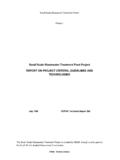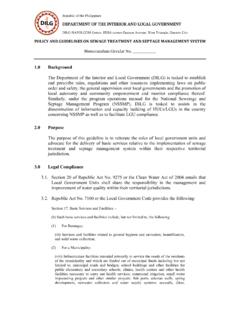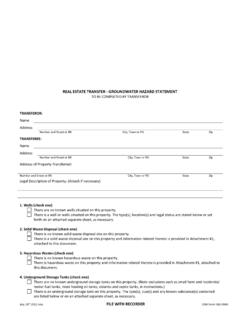Transcription of Sanitary Sewer Overflows - United States Environmental ...
1 Sanitary Sewer Overflows Sanitary Sewer Overflows What are they and how can we reduce them? EPA 832-K-96-001 - Summer 1996. What are Sanitary Sewer Overflows ? A Sanitary Sewer overflow can spill raw sewage into basements or out of manholes and onto city streets, playgrounds and into streams, before it can reach a treatment facility. Why are SSOs a problem? EPA has found that Sanitary Sewer Overflows (SSOs) caused by poor Sewer collection system management pose a substantial health and Environmental challenge in some parts of our nation. The response to this challenge varies considerably from state to state. Many municipalities have asked for national consistency in the way permits are considered for wastewater discharges, including SSOs, and in enforcement of the law prohibiting unpermitted discharges.
2 In response, EPA has convened representatives of States , municipalities, health agencies, and Environmental advocacy groups to advise the Agency on how to best meet this challenge. This Federal Advisory Subcommittee examines the need for national consistency in permitting and enforcement, effective Sewer operation and maintenance principles, public notification for SSOs with potential health or Environmental dangers, and other public policy issues. EPA carefully considers the Subcommittee recommendations for regulatory and nonregulatory actions to reduce SSOs nationally. Why Do Sewers Overflow SSOs occasionally occur in almost every Sewer system even though systems are intended to collect and contain all the sewage that flows into them.
3 When SSOs happen frequently, however, it means something is wrong with the system. Problems that can cause chronic SSOs include: Too much rainfall or snowmelt infiltrating through the ground into leaky Sanitary sewers, which are not intended to hold rainfall or to drain property. Excess water can also inflow through roof drains connected to sewers and broken or badly connected Sewer service lines Sewers and pumps too small to carry sewage from newly-developed subdivisions or commercial areas Blocked, broken or cracked pipes and other equipment or power failures that keep the system from doing its job. Tree roots can grow into the Sewer . Sections of pipe can settle or shift so that pipe joints no longer match.
4 Sediment and other material can build up and cause pipes to break or collapse. This can also happen to Sewer service connections to houses and other buildings. Some cities estimate that as much as 60 percent of the water over-filling their Sewer systems comes from service lines. The chat below shows major types of problems that cause SSOs most frequently. A deteriorating Sewer system. When sewers are not properly installed or maintained, widespread problems that can be expensive to fix develop over time. Some municipalities have found severe problems, necessitating billion-dollar correction programs. Often, communities have had to curtail new development until problems are corrected or system capacity is increased.
5 What Health Risks Do SSOs Present Because SSOs contain raw sewage they can carry bacteria, viruses, protozoa (parasitic organisms), helminths (intestinal worms), and borroughs (inhaled molds and fungi). The diseases they may cause are shown in the table below and range in severity from mild gastroenteritis (causing stomach cramps and diarrhea) to life-threatening ailments such as cholera, dysentery, infections hepatitis, and severe gastroenteritis. PATHOGENS IN RAW sewage (6). ORGANISMS DISEASES AND SYMPTOMS. ============= ======================================== =. Bacteria Chlorea, salmonellosis (food poisoning), typhoid fever, bacillary dysentery, gas . troenteritis (including diarrhea and abdominal pain).
6 Viruses Hepatitis, meningitis, pneumonia, fever, common colds, paralysis, encephalitis, gastroenteritis, diarrhea, respiratory infections Protozoa Gastroenteritis, acute enteritis, giardiasis (including diarrhea, abdominal cramps, and weight loss), dysentery, toxoplasmosis, crypotosporidiosis Helminths Digestive and nutritional disturbances, abdominal pain, vomiting, restlessness, coughing, chest pain, fever, abdominal pain, diarrhea, anemia, weight loss, fever, muscle aches, nervousness, insomnia, anorexia, hookworm disease, taeniasis Bioaerosols Allergic reactions (such as asthma), Legionnaire's disease People can be exposed through: sewage in drinking water sources. Direct contact in areas of high public access such as basements, lawns or streets, or to waters used for recreation.
7 At least one study has estimated a direct relationship between gastrointestinal illness contracted while swimming and bacteria levels in the water(1). Shellfish harvested from areas contaminated by raw sewage . One study indicates that an average of nearly 700 cases of illness per year were reported in the 1980s from eating shellfish contaminated by sewage and other sources. The number of unreported cases is estimated to be 20 times that(2). Some cases of disease contracted through inhalation and skin absorption have also been documented (3). What Other Damage Can SSOs Do? SSOs also damage property and the environment. When basements flood, the damaged area must be thoroughly cleaned and disinfected to reduce the risk of disease.
8 Cleanup can be expensive for homeowners, and municipalities. Rugs, curtains, flooring, wallboard panels, and upholstered furniture usually must be replaced. A key concern with SSOs which enter rivers, lakes, streams, or brackish waters is their effect on water quality. When bodies of water cannot be used for drinking water, fishing, or recreation, society experiences an economic loss. Tourism and water front home values may fall. Fishing and shellfish harvesting may be restricted or halted. SSOs can also close beaches. One 1994 study claims that SSOs closed beaches across the nation that year for more than 300 days(4). How Big Is The Problem? The total number of SSOs that occur nationwide each year is not known.
9 In some areas, they might not be reported or are underreported to EPA and state Environmental agencies. Two surveys, however, hep to define the size of the problem: In a 1994 survey of 79 members of the Association of Metropolitan Sewerage Agencies, 65. percent of the respondents reported wet weather SSOs(5). They reported that between 15 and 35 percent of their sewers were filled above capacity and/or overflowed during wet weather. However, municipal respondents with SSOs had only limited information about them. Only 60. percent had estimated the annual number. half of those had estimated the amount of sewerage discharged, and 17 percent had determined what pollutants were in their Overflows .
10 A 1981 survey conducted by the National Urban Institute indicated an average of 827 backups and 143 breaks per 1,000 miles of Sewer pipe (about 1,000 miles of Sewer pipe are needed to serve 250,000 people.) per year. Breaks occurred most often in the young, growing cities of the South and West. The report authors suggested that cities with the most collection system problems were doing the least to correct them---even cleaning pipes at a very low rate. How Can SSOs Be Reduced Or Eliminated Many avoidable SSOs are caused by inadequate or negligent operation or maintenance, inadequate system capacity, and improper system design and construction. These SSOs can be reduced or eliminated by: Sewer system cleaning and maintenance Reducing infiltration and inflow through system rehabilitation and repairing broken or leaking service lines.


















